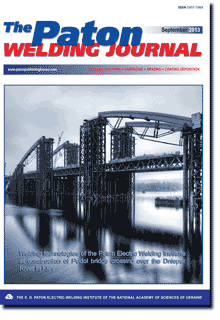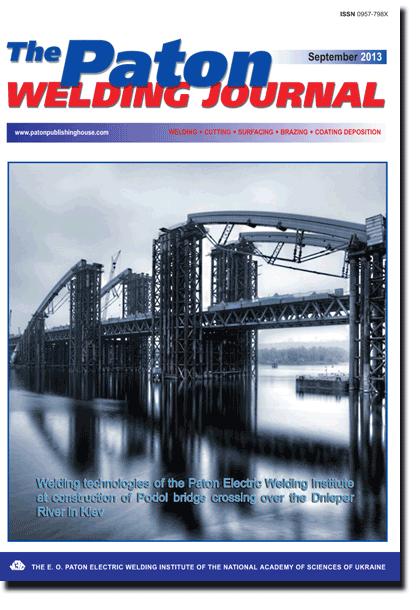| 2013 №09 (05) | 2013 №09 (07) |

The Paton Welding Journal, 2013, #9, 37-40 pages
MECHANICAL PROPERTIES OF JOINTS OF HEAT-RESISTANT 10Kh12M, 10Kh9MFBA GRADE STEELS, MADE BY ELECTRON BEAM WELDING
V.M. NESTERENKOV, L.A. KRAVCHUK and Yu.A. ARKHANGELSKY
E.O. Paton Electric Welding Institute, NASU. 11 Bozhenko Str., 03680, Kiev, Ukraine. E-mail: office@paton.kiev.uaAbstract
In the course of development of works on the technology of electron beam welding of special steels the investigations of properties of the joints of heat-resistant 10Kh12M, 10Kh9MFBA grade steels of dm = 30mm thickness, made by single- and multipass electron beam welding using horizontal electron beam at the speed of vw = 3 mm/s without preheating, were carried out. The results of mechanical tests on rupture and impact toughness and also nature of fracture after electron beam welding and after it with the next tempering are given. It was established that toughness and ductility of welded joints of both heat-resistant steels after the first main pass and after the second one in electron beam welding with the next tempering are preserved almost at the same level. The fracture of welded specimens of both alloys, oriented across the weld metal, occurs along the base metal far from the weld, beyond the heat affected zone. The fracture surface is dull. The formed relief has characteristic features of plastic fracture. As a result of tempering the strength of welded joints of both alloys decreases not considerably, and toughness with ductility increase. The third of the passes in electron beam welding results in formation of defects in a form of middle cracks and brittle low-ductile structures in weld structure and near-weld zone. 7 Ref., 2 Tables, 3 Figures.
Keywords: electron beam welding, heat-resistant steels, welded joints, welding speed, preheating, tempering, strength, toughness, elongation, reduction in area, number of passes
Received: 13.06.13
Published: 28.09.13
References
1. Nesterenkov, V.M., Kravchuk, L.A., Arkhangelsky, Yu.A. et al. (2013) Welds formation in EBW of heat-resistant steels of the grades 10Kh12M and 10Kh9MFBA. The Paton Welding J., 6, 38-42.
2. Shida, T., Kita, H., Okamura, H. et al. Effect of welding parameters and prevention of defects in deep penetration EBW of heavy section steel. IIW Doc. IV-239-78.
3. Koshelev, Yu.V., Kovbasenko, S.N. (1985) Weld width as a criterion of hot cracking in electron beam welding . In: Proc. of Int. Conf. on Electron Beam Technologies (Varna, 26 May-2 June). Sofia, 1985.
4. Kasatkin, B.S., Kovbasenko, S.N., Nesterenko, V.I. (1989) One-pass electron beam welding of large thickness structural steels. Avtomatich. Svarka, 4, 18-27.
5. Paton, B.E., Leskov, G.I., Zhivaga, L.I. (1976) Specifics of weld formation in electron beam welding. Ibid., 3, 1-5.
6. Morochko, V.P., Sorokin, L.I., Zorin, N.Ya. (1975) Influence of electron beam welding conditions on weld shape and properties of 10-15 mm thick welded joints of heat-resistant alloys. Svarochn. Proizvodstvo, 6, 32-36.
7. Sorokin, L.I. (1998) Electron beam welding of heat-resistant alloys. Ibid., 5, 9-15.
Suggested Citation
V.M. NESTERENKOV, L.A. KRAVCHUK and Yu.A. ARKHANGELSKY (2013) MECHANICAL PROPERTIES OF JOINTS OF HEAT-RESISTANT 10Kh12M, 10Kh9MFBA GRADE STEELS, MADE BY ELECTRON BEAM WELDING. The Paton Welding J., 09, 37-40.The cost of subscription/purchase order journals or individual articles
| Journal/Currency | Annual Set | 1 issue printed |
1 issue |
one article |
| TPWJ/USD | 384 $ | 32 $ | 26 $ | 13 $ |
| TPWJ/EUR | 348 € | 29 € | 24 € | 12 € |
| TPWJ/UAH | 7200 UAH | 600 UAH | 600 UAH | 280 UAH |
| AS/UAH | 1800 UAH | 300 UAH | 300 UAH | 150 UAH |
| AS/USD | 192 $ | 32 $ | 26 $ | 13 $ |
| AS/EUR | 180 € | 30 € | 25 € | 12 € |
| SEM/UAH | 1200 UAH | 300 UAH | 300 UAH | 150 UAH |
| SEM/USD | 128 $ | 32 $ | 26 $ | 13 $ |
| SEM/EUR | 120 € | 30 € | 25 € | 12 € |
| TDNK/UAH | 1200 UAH | 300 UAH | 300 UAH | 150 UAH |
| TDNK/USD | 128 $ | 32 $ | 26 $ | 13 $ |
| TDNK/EUR | 120 € | 30 € | 25 € | 15 € |
AS = «Automatic Welding» - 6 issues per year;
TPWJ = «PATON WELDING JOURNAL» - 12 issues per year;
SEM = «Electrometallurgy Today» - 4 issues per year;
TDNK = «Technical Diagnostics and Non-Destructive Testing» - 4 issues per year.


